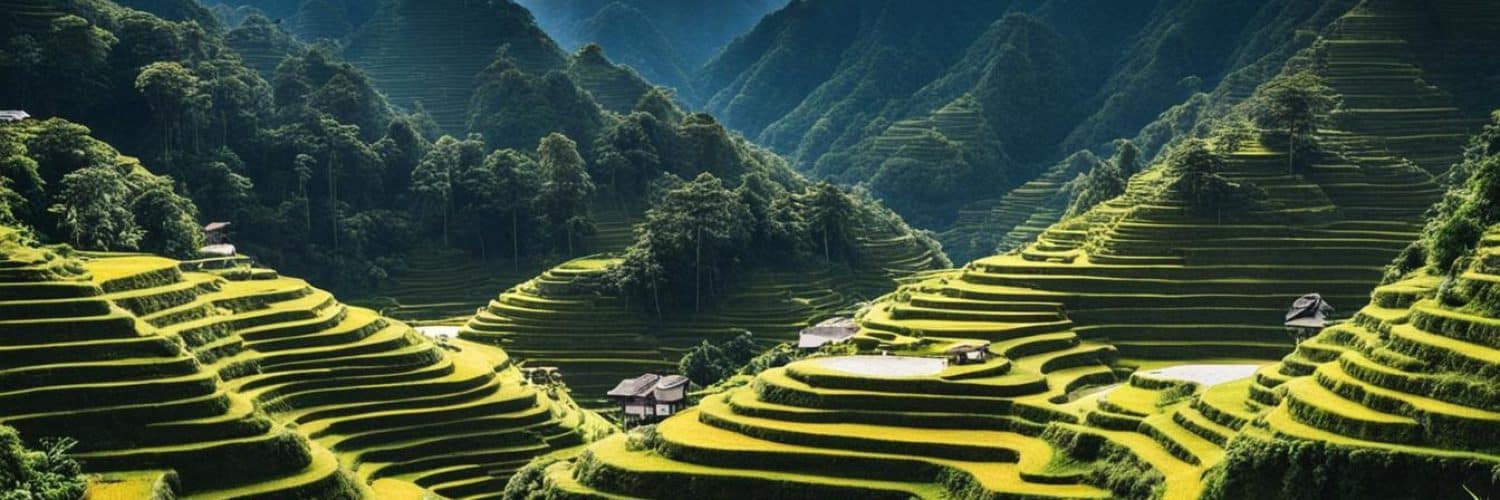The Banaue Rice Terraces, located in the picturesque province of Ifugao in the Philippines, are an awe-inspiring sight to behold. These magnificent terraces, often referred to as the Philippine rice terraces, are not only a UNESCO World Heritage Site but also a cultural landmark and a popular tourist attraction.
Believed to be more than 2,000 years old, the Banaue Rice Terraces are an ancient engineering marvel that showcases the ingenuity and sustainable farming practices of the Igorot people. Carved into the mountains by hand, these terraces reflect the harmonious relationship between humans and nature, demonstrating how the Ifugao community developed a complex irrigation system to sustain their crops and create a breathtaking scenic landscape.
In recent years, the preservation of these terraces has become a pressing concern. Climate change, erosion, and the impact of the tourism industry pose threats to the future of this cultural heritage site. It is crucial for us to raise awareness about the importance of sustainable farming and responsible tourism to protect this invaluable treasure for generations to come.
Key Takeaways:
- The Banaue Rice Terraces are a UNESCO World Heritage Site and a cultural landmark in Ifugao, Philippines.
- They represent an ancient engineering marvel and sustainable farming practices.
- Preservation efforts are necessary to combat the threats of climate change, erosion, and tourism impact.
- Supporting responsible tourism and sustainable farming is crucial for the longevity of the terraces.
- Exploring the Banaue Rice Terraces is an opportunity to immerse in the rich heritage and breathtaking beauty of Ifugao.
Cultural Significance of the Banaue Rice Terraces
The Banaue Rice Terraces in Ifugao, Philippines, hold immense cultural and historical significance. These terraces were meticulously constructed over 2,000 years ago by the ingenious ancestors of the Igorot people. Through their bare hands and ancient engineering techniques, they carved these magnificent terraces into the mountains, showcasing their remarkable skills and deep connection to the land.
Unlike conventional rice fields, the Banaue Rice Terraces feature an intricate irrigation system that allows for year-round flooding and sustains the crops. This sustainable farming practice demonstrates the wisdom and foresight of the Ifugao community, who have managed to preserve their natural resources for centuries.
The terraces serve as a symbol of sustainable agriculture, showing how ancient civilizations were able to coexist harmoniously with the environment. Historically, the rice terraces played a vital role in the food security and self-sufficiency of the Ifugao people, ensuring their survival in the challenging mountainous terrain.
Today, the cultural significance of the Banaue Rice Terraces encompasses more than just their engineering marvel and agricultural importance. They are a testament to the rich heritage and traditions of the Ifugao community, allowing visitors to glimpse into their way of life and the deep spiritual connection they have with the land.
The terraces have become an emblem of Ifugao identity, showcasing their resilience, ingenuity, and cultural heritage. They continue to be a source of pride for the local community, serving as a reminder of their ancestors’ achievements and the enduring legacy of sustainable farming practices.
Threats to the Banaue Rice Terraces
The Banaue Rice Terraces, a cultural and historical landmark in Ifugao, face several threats to their preservation. One of the most significant challenges is climate change, which has led to more intense and frequent typhoons in the region. These extreme weather events cause erosion and damage to the structures that support the terraces, jeopardizing their stability and long-term viability.
This erosion is further compounded by the unchecked growth of wild weeds and bamboo, which have taken root in some terraces. As a result, farmers have been forced to abandon these areas, leading to the gradual deterioration and loss of these ancient green steps.
Another threat to the Banaue Rice Terraces comes from the allure of higher wages in the tourism industry. As more locals are enticed by the prospect of better income opportunities, they choose to abandon their farming practices and instead work as construction workers or tourist guides. This neglect and abandonment of the terraced fields pose a significant risk to their survival.
To ensure the preservation of this UNESCO World Heritage Site, proactive measures must be taken to address these threats. Sustainable farming practices, such as agroforestry and soil conservation techniques, should be implemented to mitigate erosion and maintain the structural integrity of the terraces. Efforts should also be made to educate and raise awareness among locals about the cultural and historical significance of the Banaue Rice Terraces.
“Preserving the Banaue Rice Terraces is not just about conserving a scenic landscape; it’s about safeguarding a living testament to the ancient engineering ingenuity and sustainable farming practices of the Ifugao people.”
Best Time to Visit Banaue
When planning a trip to the Banaue Rice Terraces in Ifugao, it’s important to consider the best time to visit to fully experience the breathtaking beauty of this UNESCO World Heritage Site. The lush green terraces are a sight to behold, and certain months offer the most picturesque views of this ancient engineering marvel.
The Ideal Months: April to May and October to November
If you want to witness the terraces in their full splendor, plan your visit during the months of April to May or October to November. During these times, the terraces are vibrant with lush vegetation and the colors are at their most captivating. It is the perfect opportunity to capture stunning photographs and immerse yourself in the awe-inspiring scenery.
These months also offer pleasant weather, with moderate temperatures and a lower chance of rain. You will have a greater chance of clear skies, allowing you to fully appreciate the grandeur of the Banaue Rice Terraces.
Avoiding the Rainy Season: July and August
While Banaue is beautiful throughout the year, it’s advisable to avoid visiting during the rainy season, particularly in July and August. The heavy rainfall during these months can lead to landslides and make access to hiking and trekking activities more challenging. To ensure your safety and enjoy the full range of outdoor experiences, it’s best to plan your visit outside of these rainy months.
By choosing the best time to visit Banaue, you can make the most of your trip and create lasting memories of the awe-inspiring Banaue Rice Terraces.
How to Get to Banaue
Getting to Banaue, home to the marvelous Banaue Rice Terraces, requires land transportation as there are no direct flights to Ifugao province. Here are the main routes to reach this breathtaking destination.
From Manila
Starting from Manila, the capital city of the Philippines, you can take a bus to Banaue. Buses operate daily, offering a convenient and scenic journey that takes approximately 9 hours. Sit back, relax, and enjoy the picturesque landscapes along the way.
From Baguio
If you’re coming from Baguio, a popular tourist destination known for its cool climate and stunning views, you can also catch a bus directly to Banaue. The journey from Baguio to Banaue takes around 3 hours, allowing you to enjoy a shorter trip.
From Sagada
Another option for reaching Banaue is by traveling from Sagada, a charming town famous for its hanging coffins and limestone caves. The bus ride from Sagada to Banaue typically takes around 3 hours, treating you to more breathtaking scenery along the way.
It’s important to note that the road conditions can be challenging, especially in the mountainous regions. However, the stunning views and unforgettable experience of visiting the Banaue Rice Terraces make this journey well worth the effort.
| Starting Point | Transportation Option | Approximate Travel Time |
|---|---|---|
| Manila | Bus | 9 hours |
| Baguio | Bus | 3 hours |
| Sagada | Bus | 3 hours |
Where to Stay in Banaue
If you’re planning a visit to the Banaue Rice Terraces in Ifugao, there are several accommodations available in the area to suit various preferences and budgets. Whether you prefer to be in the heart of Banaue town proper or surrounded by the natural beauty of Batad, there are options to meet your needs.
Batad: Secluded Charm
If you’re looking for a truly immersive experience amidst the rice terraces, Batad is the perfect place to stay. Known for its secluded charm, this village offers a peaceful retreat away from the hustle and bustle. However, please note that reaching Batad requires a 20-minute hike, so be prepared for a short trek to access your accommodations. The picturesque surroundings and stunning views of the rice terraces make it a worthwhile experience.
Banaue Town Proper: Convenience and Accessibility
If convenience and accessibility are more important to you, staying in Banaue town proper is a great option. Here, you’ll find a range of accommodations that provide value for money and easy access to various attractions and facilities. From cozy guesthouses to charming inns, Banaue town proper offers a comfortable base for exploring the Banaue Rice Terraces and other nearby attractions.
While luxury hotels or resorts may not be available in the area, the accommodations available in both Batad and Banaue town proper offer a unique charm and stunning views of the rice terraces. It’s recommended to book your accommodations in advance, especially during peak seasons, to secure your preferred choice.
| Accommodation | Location | Description |
|---|---|---|
| Batad View Inn | Batad | A rustic inn nestled in the heart of Batad, offering stunning views of the rice terraces. |
| Uyami’s Green View Lodge | Batad | A cozy lodge with comfortable rooms and a terrace overlooking the rice terraces. |
| Banaue Homestay | Banaue town proper | An authentic homestay experience with friendly hosts, providing a glimpse into the local culture. |
| Banaue Hotel and Youth Hostel | Banaue town proper | A budget-friendly option with basic amenities and a convenient location in the town center. |
With comfortable and charming accommodations available in both Batad and Banaue town proper, you can choose the perfect option based on your preferences and priorities. Whether you seek secluded charm or convenience and accessibility, your stay in Banaue will offer a memorable experience amidst the magnificence of the Banaue Rice Terraces.
Things to See and Do in Banaue
In addition to exploring the Banaue Rice Terraces, there are several other attractions and activities to enjoy in Banaue. Immerse yourself in the Ifugao culture at Tam-An Village, where you can learn about traditional practices and interact with the locals. Take a hike to Tappiyah and Chappah Falls to witness the natural beauty of the area, or visit the Cordillera Sculpture Museum to learn about the region’s art and history. Don’t miss the opportunity to discover the unique charm of Batad, another stunning rice terrace destination. And, of course, indulge in the local cuisine and culinary delights that Banaue has to offer.
Immerse Yourself in Ifugao Culture at Tam-An Village
“Exploring the traditional practices and interacting with the locals at Tam-An Village allows you to truly understand the rich Ifugao culture.”
Witness the Natural Beauty of Tappiyah and Chappah Falls
“Embark on a hike to Tappiyah and Chappah Falls for an unforgettable experience of Banaue’s breathtaking natural wonders.”
Discover the Art and History of the Region at Cordillera Sculpture Museum
Visit the Cordillera Sculpture Museum to delve into the art and history of the Ifugao region. Admire the intricate sculptures and learn about their cultural significance.
Explore the Charming Batad Rice Terraces
Don’t miss the opportunity to visit Batad, another stunning rice terrace destination near Banaue. Experience the unique charm of this secluded village and marvel at its awe-inspiring landscapes.
Indulge in Culinary Adventures
While in Banaue, be sure to savor the flavors of the local cuisine. Try traditional Ifugao delicacies such as tinawon rice and pinuneg (blood sausage). Feast on hearty meals like pinikpikan (native chicken dish) and hinalo (pork dish), and enjoy the abundance of fresh vegetables grown in the terraces. Complete your culinary adventure with a taste of the local rice wine, known as bayah.
What to Eat in Banaue
Banaue is a paradise for food lovers, offering a delectable array of local dishes and culinary delights that will tantalize your taste buds. Immerse yourself in the rich flavors and unique gastronomy of this vibrant destination, where traditional Ifugao delicacies take center stage. From their famous “tinawon” rice to the savory pinuneg (blood sausage), Banaue showcases the diversity and richness of Ifugao cuisine.
Indulge in hearty meals like “pinikpikan,” a native chicken dish prepared through a traditional process of batukan, which involves repeatedly beating the chicken with a stick to tenderize the meat. The result is a flavorful and succulent dish that embodies the essence of Ifugao cooking. Another must-try dish is “hinalo,” a pork dish that combines tender pork pieces with a delightful medley of spices and herbs.
One of the highlights of Banaue’s culinary scene is the abundance of fresh vegetables grown in the terraces themselves. Experience the farm-to-table concept as you savor the vibrant flavors of locally grown produce, including crisp lettuce, juicy tomatoes, and crunchy cucumbers. These vegetables are cultivated using traditional farming methods passed down through generations, resulting in unparalleled freshness and quality.
No visit to Banaue is complete without sampling the local rice wine, known as “bayah.” Made from fermented rice, this traditional drink offers a unique and authentic taste of the region. Sip on this aromatic and slightly sweet beverage as you soak in the breathtaking views of the Banaue Rice Terraces, elevating your culinary experience to new heights.
Sample Menu
| Dish | Description |
|---|---|
| Tinawon Rice | A traditional Ifugao rice variety known for its distinct flavor and aroma. |
| Pinuneg | A savory blood sausage made from pig’s blood, rice, and spices. |
| Pinikpikan | A native chicken dish prepared through the traditional batukan process. |
| Hinalo | A flavorful pork dish seasoned with aromatic herbs and spices. |
| Fresh Vegetable Salad | A refreshing mix of locally grown lettuce, tomatoes, cucumbers, and other seasonal vegetables. |
| Bayah | A traditional rice wine with a sweet and fragrant taste. |
Practical Information and Tips for Visiting Banaue
When planning a trip to the breathtaking Banaue Rice Terraces in Ifugao, Philippines, it’s essential to be well-prepared and equipped with practical information and travel tips. Here are some helpful tips to ensure a smooth and enjoyable visit:
- Be prepared for a long journey: The road conditions can be challenging, so expect a lengthy drive regardless of your starting point. Plan accordingly and make sure to allocate enough time for the journey.
- Pack appropriate clothing and gear: Banaue offers incredible opportunities for hiking and trekking, so bring comfortable and suitable clothing, sturdy footwear, and essential hiking gear. Don’t forget to pack essentials like sunscreen and a hat to protect yourself from the sun.
- Respect local culture and customs: The Ifugao people have a rich cultural heritage, so it’s important to be respectful and mindful of their customs. Familiarize yourself with their traditions and practices, and always ask for permission before taking photos of individuals or sacred sites.
- Stay hydrated and bring insect repellent: Banaue’s outdoor activities can be physically demanding, so it’s crucial to stay hydrated throughout the day. Carry a water bottle with you and refill it whenever possible. Additionally, don’t forget to bring insect repellent to protect yourself from mosquitoes and other bugs.
- Practice sustainable tourism: The Banaue Rice Terraces are not only a beautiful natural wonder but also an important cultural and environmental heritage. Respect the ecosystem and local community by practicing sustainable tourism. Avoid littering, stay on designated trails, and be mindful of your environmental impact.
- Plan your itinerary and accommodations in advance: Banaue attracts a significant number of visitors, especially during peak seasons. To secure the best accommodations and make the most of your visit, it’s advisable to plan your itinerary in advance and book accommodations ahead of time.
- Engage with local guides and communities: To truly immerse yourself in the culture and gain a deeper understanding of the Banaue Rice Terraces, consider hiring a local guide. They can offer valuable insights and take you to hidden gems that you might otherwise miss. Engaging with the local community also provides an opportunity to support their livelihoods and contribute to the sustainable development of the region.
Remember, visiting the Banaue Rice Terraces is a unique experience that allows you to witness the awe-inspiring beauty of this ancient wonder. By following these practical tips, you can ensure a memorable and rewarding journey while respecting the local culture and preserving the sustainability of this magnificent destination.
Conclusion
The Banaue Rice Terraces in Ifugao, Philippines, are not only a breathtaking natural wonder but also a testament to the ancient engineering skills and sustainable farming practices of the Igorot people. These terraces hold immense cultural heritage and have been recognized as a UNESCO World Heritage Site. However, the preservation of this magnificent landscape is paramount.
Visiting Banaue, supporting local communities, and practicing responsible tourism are crucial steps towards preserving the Banaue Rice Terraces. By immersing ourselves in the rich Ifugao culture, we can gain a deeper appreciation for the terraces’ significance and the sustainable farming techniques employed for centuries.
It is essential to acknowledge the importance of safeguarding this heritage site for future generations. With our conscious efforts, we can ensure the preservation of these terraces, allowing them to continue captivating visitors and showcasing the ingenuity and legacy of the Igorot people. Together, we can contribute to the sustainable growth and long-term preservation of the Banaue Rice Terraces.
FAQ
What are the Banaue Rice Terraces?
The Banaue Rice Terraces are a network of terraced rice fields carved into the mountains by the ancestors of the Igorot people in Ifugao, Philippines.
Why are the Banaue Rice Terraces considered a cultural and historical landmark?
The Banaue Rice Terraces represent the ancient engineering marvel of terraced farming and are deeply rooted in the culture and heritage of the Ifugao community.
What threats do the Banaue Rice Terraces face?
The Banaue Rice Terraces face threats from climate change, erosion, and the allure of higher wages in the tourism industry, which leads to neglect and abandonment.
When is the best time to visit Banaue?
The best time to visit Banaue is during the months of April to May and October to November when the terraces offer the greenest and most picturesque views.
How do I get to Banaue?
Banaue can be reached via land transportation from Manila, Baguio, or Sagada. The road conditions can be challenging, so it is advisable to plan for a long journey.
Where should I stay in Banaue?
Banaue offers accommodations in the Banaue town proper and Batad. Batad is known for its secluded charm, but it requires a 20-minute hike to reach.
What are some things to see and do in Banaue?
In addition to exploring the Banaue Rice Terraces, you can visit Tam-An Village to immerse yourself in the Ifugao culture, hike to Tappiyah and Chappah Falls, or visit the Cordillera Sculpture Museum.
What should I eat in Banaue?
Banaue offers a variety of local dishes and culinary delights, including traditional Ifugao delicacies like “tinawon” rice and pinuneg (blood sausage).
What are some practical tips for visiting Banaue?
Some practical tips for visiting Banaue include being prepared for a long journey, packing appropriate clothing and gear, respecting the local culture, and practicing sustainable tourism.
Why is the preservation of the Banaue Rice Terraces important?
The preservation of the Banaue Rice Terraces is important to ensure the survival of this UNESCO World Heritage Site and to protect the ancient engineering skills and sustainable farming practices of the Igorot people.


















Add comment